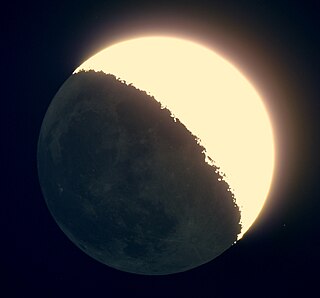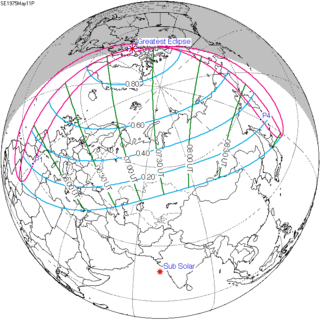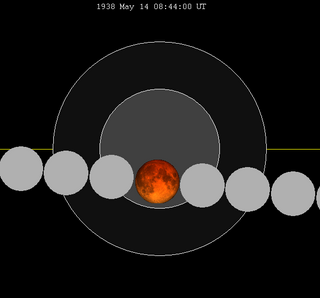
A total lunar eclipse took place on Thursday, April 2, 1931, not visible in Washington. [1]

A total lunar eclipse took place on Thursday, April 2, 1931, not visible in Washington. [1]
| Descending node | Ascending node | |||||
|---|---|---|---|---|---|---|
| Saros | Date Viewing | Type Chart | Saros | Date Viewing | Type Chart | |
| 111 | 1930 Apr 13  | Partial | 116 | 1930 Oct 07  | Partial | |
| 121 | 1931 Apr 02  | Total | 126 | 1931 Sep 26  | Total | |
| 131 | 1932 Mar 22  | Partial | 136 | 1932 Sep 14  | Partial | |
| 141 | 1933 Mar 12  | Penumbral | 146 | 1933 Sep 04  | Penumbral | |
| | This section is empty. You can help by adding to it. (October 2020) |

The full moon is the lunar phase when the Moon appears fully illuminated from Earth's perspective. This occurs when Earth is located between the Sun and the Moon. This means that the lunar hemisphere facing Earth—the near side—is completely sunlit and appears as an approximately circular disk. The full moon occurs roughly once a month.

In astronomy, the new moon is the first lunar phase, when the Moon and Sun have the same ecliptic longitude. At this phase, the lunar disk is not visible to the naked eye, except when it is silhouetted against the Sun during a solar eclipse.
His Majesty's Nautical Almanac Office (HMNAO), now part of the United Kingdom Hydrographic Office, was established in 1832 on the site of the Royal Observatory, Greenwich (ROG), where The Nautical Almanac had been published since 1767. HMNAO produces astronomical data for a wide range of users, such as astronomers, mariners, aviators, surveyors, the military, Police, lawyers, religious groups, architects, schools, diary and calendar manufacturers, photographers and film crews.

Epsilon Carinae, officially named Avior, is a binary star in the southern constellation of Carina. At apparent magnitude +1.86 it is one of the brightest stars in the night sky, but is not visible from most of the northern hemisphere. The False Cross is an asterism formed of Delta Velorum, Kappa Velorum, Iota Carinae and ε Carinae. It is so called because it is sometimes mistaken for the Southern Cross, causing errors in astronavigation.
Richard Dunthorne was an English astronomer and surveyor, who worked in Cambridge as astronomical and scientific assistant to Roger Long, and also concurrently for many years as surveyor to the Bedford Level Corporation.
The American Ephemeris and Nautical Almanac was published for the years 1855 to 1980, containing information necessary for astronomers, surveyors, and navigators. It was based on the original British publication, The Nautical Almanac and Astronomical Ephemeris, with which it merged to form The Astronomical Almanac, published from the year 1981 to the present.

The lunar limb is the edge of the visible surface (disc) of the Moon as viewed from Earth. Seen from afar, it looks like a circular arc, but with higher resolution, we can see that the Moon’s surface is not flat and therefore its profile is irregular.
The Nautical Almanac has been the familiar name for a series of official British almanacs published under various titles since the first issue of The Nautical Almanac and Astronomical Ephemeris, for 1767: this was the first nautical almanac to contain data dedicated to the convenient determination of longitude at sea. It was originally published from the Royal Greenwich Observatory in England. A detailed account of how the publication was produced in its earliest years has been published by the National Maritime Museum.

A penumbral lunar eclipse took place on Thursday, 18 August 2016. It was the second of three lunar eclipses in 2016. This was 3.7 days before the Moon reached perigee. There are multiple ways to determine the boundaries of Earth's shadow, so this was a miss according to some sources. The HM National Almanac Office's online canon of eclipses lists this event as the last eclipse on Saros Series 109, while NASA lists August 8, 1998 as the last eclipse of the series, and has this event missing the shadow.
A total lunar eclipse took place on Monday, October 28, 1985, the second of two total lunar eclipses in 1985, the first being on May 4, 1985.

A total lunar eclipse occurred on 26 May 2021. A lunar eclipse occurs when the Moon moves into the Earth's shadow. This can occur only when the Sun, Earth, and Moon are exactly or very closely aligned with Earth between the other two, which can only happen at a full moon. The eclipsed moon appeared as a faint red disk in the sky due to a small amount of light being refracted through the earth's atmosphere; this appearance gives a lunar eclipse its nickname of a Blood Moon.

A partial lunar eclipse will take place on November 30, 2039. At 3 hours 26 minutes, it is the longest partial lunar eclipse since November 19, 2021, which is the previous member of Lunar Saros 126.

A total lunar eclipse took place on Wednesday, October 18, 1967, the second of two total lunar eclipses in 1967, the first being on April 24, 1967.
A total lunar eclipse took place on Monday, September 15, 1913. The moon passed through the center of the Earth's shadow.

A partial solar eclipse occurred at the Moon's descending node of the orbit on Sunday, May 11, 1975. A solar eclipse occurs when the Moon passes between Earth and the Sun, thereby totally or partly obscuring the image of the Sun for a viewer on Earth. A partial solar eclipse occurs in the polar regions of the Earth when the center of the Moon's shadow misses the Earth.

A total lunar eclipse occurred on 1 March 1504, visible at sunset for the Americas, and later over night over Europe and Africa, and near sunrise over Asia.

In astronomy, a syzygy is a roughly straight-line configuration of three or more celestial bodies in a gravitational system.
A fundamental ephemeris of the Solar System is a model of the objects of the system in space, with all of their positions and motions accurately represented. It is intended to be a high-precision primary reference for prediction and observation of those positions and motions, and which provides a basis for further refinement of the model. It is generally not intended to cover the entire life of the Solar System; usually a short-duration time span, perhaps a few centuries, is represented to high accuracy. Some long ephemerides cover several millennia to medium accuracy.

In positional astronomy, two astronomical objects are said to be in opposition when they are on opposite sides of the celestial sphere, as observed from a given body.

A total lunar eclipse took place on Saturday, May 14, 1938. This was the last total lunar eclipse of Saros cycle 120. It was visible from Oceania, the Pacific Ocean, North America, South America and Antarctica.